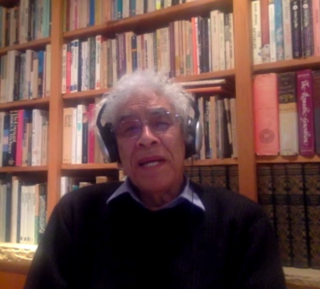Related Research Articles

Chaos theory is an interdisciplinary area of scientific study and branch of mathematics. It focuses on underlying patterns and deterministic laws of dynamical systems that are highly sensitive to initial conditions. These were once thought to have completely random states of disorder and irregularities. Chaos theory states that within the apparent randomness of chaotic complex systems, there are underlying patterns, interconnection, constant feedback loops, repetition, self-similarity, fractals and self-organization. The butterfly effect, an underlying principle of chaos, describes how a small change in one state of a deterministic nonlinear system can result in large differences in a later state. A metaphor for this behavior is that a butterfly flapping its wings in Brazil can cause a tornado in Texas.

Numerical climate models are mathematical models that can simulate the interactions of important drivers of climate. These drivers are the atmosphere, oceans, land surface and ice. Scientists use climate models to study the dynamics of the climate system and to make projections of future climate and of climate change. Climate models can also be qualitative models and contain narratives, largely descriptive, of possible futures.
The Carl-Gustaf Rossby Research Medal is the highest award for atmospheric science of the American Meteorological Society. It is presented to individual scientists, who receive a medal. Named in honor of meteorology and oceanography pioneer Carl-Gustaf Rossby, who was also its second (1953) recipient.

Numerical weather prediction (NWP) uses mathematical models of the atmosphere and oceans to predict the weather based on current weather conditions. Though first attempted in the 1920s, it was not until the advent of computer simulation in the 1950s that numerical weather predictions produced realistic results. A number of global and regional forecast models are run in different countries worldwide, using current weather observations relayed from radiosondes, weather satellites and other observing systems as inputs.
Data assimilation is a mathematical discipline that seeks to optimally combine theory with observations. There may be a number of different goals sought – for example, to determine the optimal state estimate of a system, to determine initial conditions for a numerical forecast model, to interpolate sparse observation data using knowledge of the system being observed, to set numerical parameters based on training a model from observed data. Depending on the goal, different solution methods may be used. Data assimilation is distinguished from other forms of machine learning, image analysis, and statistical methods in that it utilizes a dynamical model of the system being analyzed.

In atmospheric science, an atmospheric model is a mathematical model constructed around the full set of primitive, dynamical equations which govern atmospheric motions. It can supplement these equations with parameterizations for turbulent diffusion, radiation, moist processes, heat exchange, soil, vegetation, surface water, the kinematic effects of terrain, and convection. Most atmospheric models are numerical, i.e. they discretize equations of motion. They can predict microscale phenomena such as tornadoes and boundary layer eddies, sub-microscale turbulent flow over buildings, as well as synoptic and global flows. The horizontal domain of a model is either global, covering the entire Earth, or regional (limited-area), covering only part of the Earth. The different types of models run are thermotropic, barotropic, hydrostatic, and nonhydrostatic. Some of the model types make assumptions about the atmosphere which lengthens the time steps used and increases computational speed.

Eugenia Enriqueta Kalnay is an Argentine meteorologist and a Distinguished University Professor of Atmospheric and Oceanic Science, which is part of the University of Maryland College of Computer, Mathematical, and Natural Sciences at the University of Maryland, College Park in the United States.

Edward Ott is an American physicist most noted for his contributions to the development of chaos theory.
The North American Ensemble Forecast System (NAEFS) is a joint project involving the Meteorological Service of Canada (MSC) in Canada, the National Weather Service (NWS) in the United States, and the National Meteorological Service of Mexico (NMSM) in Mexico providing numerical weather prediction ensemble guidance for the 1- to 16-day forecast period. The NAEFS combines the Canadian MSC and the US NWS global ensemble prediction systems, improving probabilistic operational guidance over what can be built from any individual country's ensemble. Model guidance from the NAEFS is incorporated into the forecasts of the respective national agencies.

Bhupendra Nath Goswami is an Indian meteorologist, climatologist, a former director of the Indian Institute of Tropical Meteorology (IITM). and a Pisharoty Chair Professor at the Indian Institute of Science Education and Research. He is known for his researches on the Indian monsoon dynamics and is an elected fellow of all the three major Indian science academies viz. Indian National Science Academy, Indian Academy of Sciences, and the National Academy of Sciences, India as well as The World Academy of Sciences. The Council of Scientific and Industrial Research, the apex agency of the Government of India for scientific research, awarded him the Shanti Swarup Bhatnagar Prize for Science and Technology, one of the highest Indian science awards for his contributions to Earth, Atmosphere, Ocean and Planetary Sciences in 1995.

Axel Timmermann is a German climate physicist and oceanographer with an interest in climate dynamics, human migration, dynamical systems' analysis, ice-sheet modeling and sea level. He served a co-author of the IPCC Third Assessment Report and a lead author of IPCC Fifth Assessment Report. His research has been cited over 18,000 times and has an h-index of 70 and i10-index of 161. In 2017, he became a Distinguished Professor at Pusan National University and the founding Director of the Institute for Basic Science Center for Climate Physics. In December 2018, the Center began to utilize a 1.43-petaflop Cray XC50 supercomputer, named Aleph, for climate physics research.
Amy C. Clement is an atmospheric and marine scientist studying and modeling global climate change at the University of Miami's Rosenstiel School of Marine and Atmospheric Science.

Samuel George Harker Philander is a climate scientist, known for his work on atmospheric circulation and oceanic currents, particularly El Niño. He is the Knox Taylor Professor emeritus of Geosciences at Princeton University.
M. Joan Alexander is an atmospheric scientist known for her research on gravity waves and their role in atmospheric circulation.
Christa Peters-Lidard is an American hydrologist known for her work on integrating land surface modeling and data assimilation, particularly with remotely sensed measurements of precipitation.
Anne Ritger Douglass is atmospheric physicist known for her research on chlorinated compounds and the ozone layer.
Bette Otto-Bliesner is an earth scientist known for her modeling of Earth's past climate and its changes over different geological eras.
Paola Malanotte Rizzoli is a physical oceanographer known for her research on ocean circulation and sea level rise, especially with respect to flooding conditions in Venice.
Sarah Gille is a physical oceanographer at Scripps Institution of Oceanography known for her research on the role of the Southern Ocean in the global climate system.
Kerry Harrison Cook is an American climate scientist who is a professor at the University of Texas at Austin. Her research focuses on the analysis of climate variability and change in the tropics using observational analysis and high-resolution numerical modeling. Specialties include the climate of Africa and the dynamics of intense tropical rainfall. She was elected Fellow of the American Meteorological Society in 2009 and was awarded the Joanne Simpson Tropical Meteorology Research Award in 2021. She is the Chair of the American Meteorological Society's Climate Variability and Change Committee.
References
- 1 2 Cushman-Roisin, Benoit; Beckers, Jean-Marie (2011-01-01), Cushman-Roisin, Benoit; Beckers, Jean-Marie (eds.), "Chapter 22 - Data Assimilation", International Geophysics, Introduction to Geophysical Fluid Dynamics, vol. 101, Academic Press, pp. 725–760, doi:10.1016/b978-0-12-088759-0.00022-5, ISBN 9780120887590 , retrieved 2022-07-01
- 1 2 "Michael Ghil". European Geosciences Union (EGU). Retrieved 2022-01-03.
- ↑ "Michael Ghil" (PDF). Retrieved 7 July 2020.
- 1 2 3 4 "Courant Newsletters | NYU Courant". cims.nyu.edu (Fall 2011 ed.). pp. 4–5. Retrieved 2022-01-04.
- ↑ "Michael Ghil - The Mathematics Genealogy Project". www.genealogy.math.ndsu.nodak.edu. Retrieved 2021-12-16.
- ↑ "Michael Ghil". dept.atmos.ucla.edu. Retrieved 2022-01-04.
- ↑ "GHIL, Michael - Centre de formation sur l'environnement et la société". www.environnement.ens.fr (in French). Retrieved 2022-01-04.
- ↑ "The Climate Modelling Primer, 4th Edition | Wiley". Wiley.com. Retrieved 2022-07-01.
- ↑ Chown, Marcus (2004-02-28). "Chaotic heavens". New Scientist. Retrieved 2023-05-21.
- ↑ Budyko, M. I. (1969-01-01). "The effect of solar radiation variations on the climate of the Earth". Tellus. 21 (5): 611–619. Bibcode:1969Tell...21..611B. doi: 10.3402/tellusa.v21i5.10109 . ISSN 0040-2826.
- ↑ Sellers, William D. (1969-06-01). "A Global Climatic Model Based on the Energy Balance of the Earth-Atmosphere System". Journal of Applied Meteorology and Climatology. 8 (3): 392–400. Bibcode:1969JApMe...8..392S. doi: 10.1175/1520-0450(1969)008<0392:AGCMBO>2.0.CO;2 . ISSN 1520-0450.
- ↑ Ghil, Michael (1976-01-01). "Climate Stability for a Sellers-Type Model". Journal of the Atmospheric Sciences. 33 (1): 3–20. Bibcode:1976JAtS...33....3G. doi: 10.1175/1520-0469(1976)033<0003:CSFAST>2.0.CO;2 . ISSN 0022-4928.
- ↑ Hoffman, Paul F.; Kaufman, Alan J.; Halverson, Galen P.; Schrag, Daniel P. (1998-08-28). "A Neoproterozoic Snowball Earth". Science. 281 (5381): 1342–1346. Bibcode:1998Sci...281.1342H. doi:10.1126/science.281.5381.1342. PMID 9721097. S2CID 13046760.
- ↑ Benzi, R; Sutera, A; Vulpiani, A (1981-11-01). "The mechanism of stochastic resonance". Journal of Physics A: Mathematical and General. 14 (11): L453–L457. Bibcode:1981JPhA...14L.453B. doi: 10.1088/0305-4470/14/11/006 . ISSN 0305-4470. S2CID 123005407.
- ↑ Ghil, Michael; Malanotte-Rizzoli, Paola (1991), Data Assimilation in Meteorology and Oceanography, Advances in Geophysics, vol. 33, Elsevier, pp. 141–266, doi:10.1016/s0065-2687(08)60442-2, ISBN 9780120188338 , retrieved 2021-12-16
- ↑ Ghil, M.; Vautard, R. (March 1991). "Interdecadal oscillations and the warming trend in global temperature time series". Nature. 350 (6316): 324–327. Bibcode:1991Natur.350..324G. doi:10.1038/350324a0. ISSN 1476-4687. S2CID 4241857.
- ↑ Vautard, Robert; Yiou, Pascal; Ghil, Michael (1992-09-15). "Singular-spectrum analysis: A toolkit for short, noisy chaotic signals". Physica D: Nonlinear Phenomena. 58 (1): 95–126. Bibcode:1992PhyD...58...95V. doi:10.1016/0167-2789(92)90103-T. ISSN 0167-2789.
- ↑ Ghil, M.; Allen, M. R.; Dettinger, M. D.; Ide, K.; Kondrashov, D.; Mann, M. E.; Robertson, A. W.; Saunders, A.; Tian, Y.; Varadi, F.; Yiou, P. (2002). "Advanced Spectral Methods for Climatic Time Series". Reviews of Geophysics. 40 (1): 3–1–3–41. Bibcode:2002RvGeo..40.1003G. doi:10.1029/2000RG000092. ISSN 1944-9208. S2CID 6765204.
- ↑ Zaliapin, Ilya; Keilis-Borok, Vladimir; Ghil, Michael (2003-05-01). "A Boolean Delay Equation Model of Colliding Cascades. Part II: Prediction of Critical Transitions". Journal of Statistical Physics. 111 (3): 839–861. doi:10.1023/A:1022802432590. ISSN 1572-9613. S2CID 118736384.
- ↑ Santos Gutiérrez, Manuel; Lucarini, Valerio; Chekroun, Mickaël D.; Ghil, Michael (2021-05-01). "Reduced-order models for coupled dynamical systems: Data-driven methods and the Koopman operator". Chaos: An Interdisciplinary Journal of Nonlinear Science. 31 (5): 053116. arXiv: 2012.01068 . Bibcode:2021Chaos..31e3116S. doi:10.1063/5.0039496. ISSN 1054-1500. PMID 34240957. S2CID 235303689.
- ↑ Hallegatte, Stéphane; Ghil, Michael (December 2008). "Natural disasters impacting a macroeconomic model with endogenous dynamics". Ecological Economics. 68 (1–2): 582–592. doi:10.1016/j.ecolecon.2008.05.022.
- ↑ "APS Fellow Archive". aps.org. Retrieved 2022-12-10.
- ↑ "Michael Ghil got elected as an Honorary Member of the Hungarian Academy of Sciences". dept.atmos.ucla.edu. Retrieved 2022-01-03.
- ↑ "Ed Lorenz Lecture | AGU". www.agu.org. Retrieved 2022-01-03.
- ↑ "Oeaw Members Detail". www.oeaw.ac.at. Retrieved 2022-01-03.
- ↑ "Michael Ghil". European Geosciences Union (EGU). Retrieved 2022-01-03.
- ↑ Simion @Yonescat, Florin. "Honorary Fellowship (A)". The Royal Astronomical Society. Retrieved 2022-01-03.
- ↑ "Academy of Europe: Ghil Michael". www.ae-info.org. Retrieved 2022-01-03.
- ↑ Anonymous (1995). "1995 AGU Fellows". Eos, Transactions American Geophysical Union. 76 (35): 348–349. Bibcode:1995EOSTr..76..348.. doi:10.1029/95eo00213. ISSN 0096-3941.
- ↑ "John Simon Guggenheim Foundation | Michael Ghil" . Retrieved 2022-01-03.
- ↑ "List of Fellows". American Meteorological Society. Retrieved 2022-01-03.